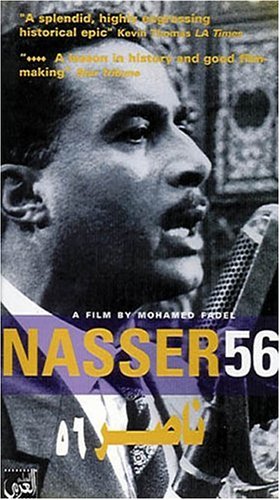
Egyptian President Gamal Abdel Nasser was one of the towering figures of the mid-20th century. The 1996 film Nasser ’56, directed by Mohamed Fadel, captures the moment in history with which he is most associated, the nationalization of the International Maritime Company, which gave Egypt control over the Suez Canal.
Nasser was barely 36 years old in 1952 when he burst upon the world stage, having overthrown the corrupt Egyptian monarchy declaring, “The spirit behind the Egyptian revolution is represented by the ideal of creating a new national consciousness in Egypt, based on the staunch belief in democratic socialism and the fullest realization of social justice.” Nasser was a complex, contradictory figure, whose reign later came to include harsh repression of communists and other progressives, helping lay the seeds of many of the problems wracking the region today.
Portrayed in this film by Ahmed Zaki, Nasser was charismatic and bold. At the time he embodied the ambitions of the Arab world in general and the Egyptian people in particular. Fortunately this film is not one of nationalistic bombast, but instead offers real insight, some occasionally comical, regarding the buildup to the so-called “Suez Crisis.” In preparation for the daring step of nationalization, one thing Nasser’s government had to do was examine if they even had the personnel capable of operating they canal once they got it, and this is well illustrated in the film.
In general, the film is paced well to build the tension and examine the dynamics of the various intrigues – and there were plenty – associated with the event. A notable aspect of this narrative is the portrayal of each moment when Nasser brings another confidant into the conspiracy. They react with a combination of pride and fear, uncertain of the outcome but resigned to taking the gamble. They are tapping into a deep reserve of resentment at the historical injustice and atrocious exploitation by the Western powers that make up the history of the construction and operation of the canal.
It is interesting to note that what precipitated the crisis, beyond the normal instinct of the Egyptians to control their own resources, was interference from the Western powers over the possible involvement of Soviet funding for the High Aswan Dam project. Once the dam was in fact completed with Soviet assistance in 1958, LIFE magazine called it, “one of the noblest possible justifications of co-existence.” Prior to those lauds, however, came the crisis of ’56, in which the Egyptian people and their president were viewed in quite a different light by the bourgeois press and the capitalist powers.
Nasser ’56 also does a good job of capturing the unique aspects of its title character. Despite the fact that Nasser could inspire and motivate millions, he was known for his personal modesty and attachment to simple tastes. In the film, when one of his children mentions that a playmate of his lives in a house that has two bathrooms, Nasser, who can scarcely conceive of why anyone would desire such a luxury, incredulously replies, “They must have a very large family.”
No less a figure than Jawaharlal Nehru said, “President Nasser is one of those men who gave a new turn to history.” That sentiment is well captured here.
“Nasser 56”
For sale: DVD in Arabic, VHS tape with English subtitles
- Actors: Ahmed Zaki, Fardous Abdel Hamid, Hassan Hosny, Ahmed Maher, Hani Ramzi
- Director: Mohamed Fadel
- Writer: Mahfouz Abdel Rahman
This film is available with a Digital Site License (DSL), which allows colleges, universities, or libraries to encode, locally host, and stream the film to their community on a closed, password-protected system.

MOST POPULAR TODAY

High Court essentially bans demonstrations, freedom of assembly in Deep South

UN warns that Israel is still blocking humanitarian aid to Gaza

U.S. imperialism’s ‘ironclad’ support for Israel increases fascist danger at home


Resource wars rage in eastern Congo, but U.S. capitalism only sees investment opportunity






Comments